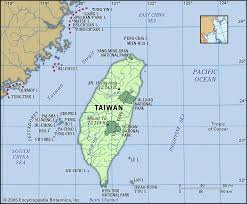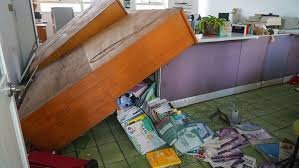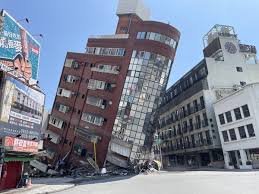In the wee hours of Wednesday, Hualien, Taiwan was disrupted when an earthquake of 7.5 magnitude hit them. This earthquake was recorded to be the biggest one is the last 25 years. This disaster has left 10 people dead and 900 injured (count still happening).
Regional Impacts
Wu Chien-fu, director of the Seismology Center at Taipei’s Central Weather Administration, remarked that the recent earthquake marked the most powerful seismic event since a 7.6-magnitude quake struck in September 1999, claiming approximately 2,400 lives in what became the deadliest natural disaster in Taiwan’s history.
 The magnitude-7.4 earthquake occurred on Wednesday just before 8:00 am local time (0000 GMT), according to data from the United States Geological Survey (USGS). The epicenter was located approximately 18 kilometers (11 miles) south of Hualien City in Taiwan, with a depth recorded at 34.8 kilometers.
The magnitude-7.4 earthquake occurred on Wednesday just before 8:00 am local time (0000 GMT), according to data from the United States Geological Survey (USGS). The epicenter was located approximately 18 kilometers (11 miles) south of Hualien City in Taiwan, with a depth recorded at 34.8 kilometers.
Authorities in Taiwan, Japan, and the Philippines initially raised alarm with tsunami warnings following a significant earthquake. However, by around 10:00 am (0200 GMT), the Pacific Tsunami Warning Center reassured that the threat had largely subsided.
In Taiwan’s capital, Taipei, the metro system briefly halted operations but swiftly resumed service within an hour. Residents received advisories from local authorities to inspect for potential gas leaks.
Meanwhile, reports surfaced from social media users in China’s Fujian province and beyond, indicating the tremors were felt in various regions.
Even in Hong Kong, residents reported sensing the earthquake’s effects.
China, which maintains territorial claims over Taiwan, closely monitored the situation and expressed readiness to offer assistance in disaster relief efforts, according to state news agency Xinhua.
The earthquake briefly disrupted operations at Taiwan Semiconductor Manufacturing Company (TSMC), the world’s largest chip manufacturer. Some fabrication activities were interrupted at certain facilities, impacting operations to a limited extent. However, TSMC swiftly mobilized resources for recovery efforts, with affected facilities expected to resume production soon.
Earthquake survivors’ encounters
A survivor described experiencing tremors that triggered rockslides resembling projectiles around the coal mine where he was employed.
Most occupants, including both guests and staff, of a secluded hotel are currently unable to depart due to road damage caused by the disaster. Authorities are now coordinating efforts to determine the most effective means of evacuation.

According to local sources, provisions have been delivered via air drops to assist the dozens of individuals trapped in these remote regions.
Describing the harrowing ordeal, a survivor identified only by the surname Chu recounted how the mountain unleashed torrents of rocks resembling bullets, leaving them with no safe haven except to seek cover beside sandbags.
Among the casualties, three of the nine deceased were hikers traversing a path leading towards Taroko National Park, renowned for its iconic gorge, situated just beyond Hualien. According to local reports, a female teacher lost her life inside the building when she went back to rescue her cat.
Dozens of miners found themselves stranded at a quarry in Hualien, adding to the urgency of rescue efforts.
Addressing reporters in Hualien, president-elect and current Vice-President Lai Ching-te stressed the importance of swiftly assessing the number of individuals trapped and expediting their rescue.
As night fell, Hualien County remained gripped by recurring aftershocks while rescue teams tirelessly sifted through rubble in search of survivors.
In a poignant gesture of remembrance, Taipei’s iconic Taipei 101 skyscraper illuminated its facade to honor the victims of the earthquake.
Indians stranded in Taiwan recollect terror faced
Rageshnath, a doctoral candidate at Taiwan’s National Dong Hwa University (NDHU), was inside his college’s Physics laboratory when the earthquake struck, marking the most severe tremor since 1999 to rock the nation. Reflecting on the terrifying experience, Rageshnath expressed feeling as though it could have been his final day.
He described the frightening sensation of the building swaying like a boat and the collapse of everything in the lab, resulting in substantial loss. Rageshnath recounted how everything in the lab collapsed, leaving him unable to see or take any action. “We’ve lost practically everything,” he lamented.

Another resident, Nirzari Gupta, highlighted the intense fear evoked by the earthquake, despite minimal physical damage. Girish Hiranandani, an export firm owner, noted improvements in Taiwan’s infrastructure, which contributed to lesser casualties compared to the devastating quake in 1999.
Anup Meena, the head of communications affairs at the India Taipei Association (ITA), stated that there are approximately 4,000 Indians residing in Taiwan, along with an additional 1,500 Indian-origin students. In response to the earthquake, the ITA promptly disseminated advisories and helpline numbers to the Indian community.Additionally, two Indian nationals were reported missing following the earthquake. However, according to Anup Meena, they were subsequently located. Confirming their safety, Randhir Jaiswal, an official spokesperson for the Ministry of External Affairs (MEA), stated, “We have now established contact with the two Indian citizens, and they are confirmed to be safe.”










